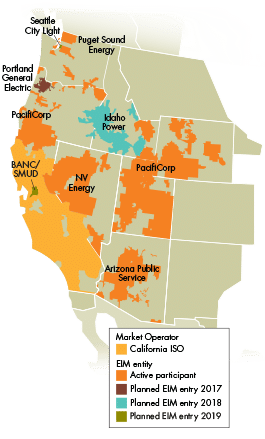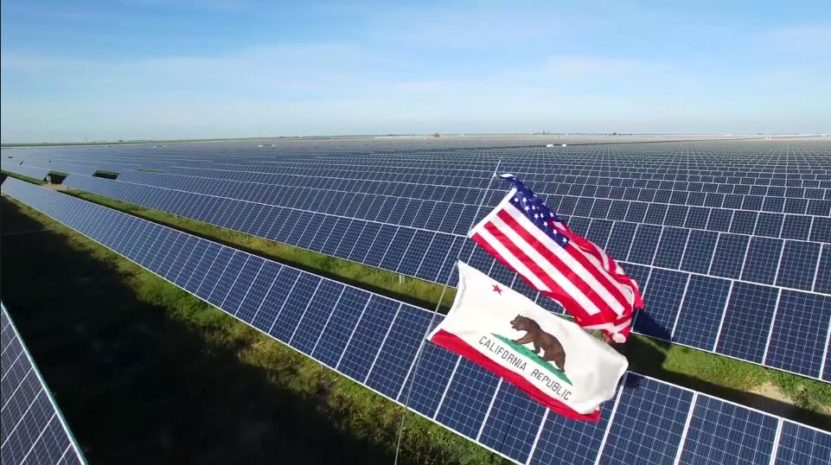Move over Germany. There is a new leader for integration of high levels of solar, and it is not located in Central Europe.
According to data released by the U.S. Department of Energy’s Energy Information Administration, of the 208 terawatt-hours (TWh) of electricity generated in California last year, 25 TWh came from solar PV, with slightly more than 1/3 of that coming from distributed generation.
Add in another 2.4 TWh from concentrating solar power, and all solar sources together represented more than 13% of the electricity generated in California in 2016. Since California imports a significant amount of electricity, the state’s solar met just under 11% of demand.
This is more than any nation known to pv magazine staff, including Honduras, which last year became the first non-island nation to generate more than 10% of its power with solar. It is also nearly 10x the average portion of solar in the United States as a whole.
California is moving quickly. The 27.4 TWh of solar generation in 2016 is roughly a third more than in 2015, which matches the state’s progress in deployment. According to GTM Research and Solar Energy Industries Association, California installed 5.1 GW of solar last year, which brought the state to over 17 GW by the end of the year.
Despite the higher portion of electricity demand met with solar, Germany still enjoys a healthy lead in volume. California hosts less than half the watts of solar that are installed in Germany, however California also has half the population, and additionally solar is much more productive in sunny California.
Technical challenges and approaches
All of this is not coming without consequence. On certain days non-hydro renewable energy has been peaking at more than 50% of system demand and an increasing amount of solar is being curtailed on California’s grid. Due to a combination of increasing solar and high hydroelectric generation due to an exceptionally rainy winter, California is expected to curtail a record 6-8 GW of renewable energy this spring.
So far solar is bearing the brunt of curtailment, and despite this wasting of local renewable energy the state continues to import large amounts of electricity even on days when curtailment is at its peak.
However, the state is also making substantial progress in readying its grid for higher levels of renewable energy. California’s grid operator has led the creation of real-time regional energy market, which now includes six additional grid operators in parts of eight states.
 “The Western Energy Imbalance Market has been a key and growing tool to help the ISO manage significant swings in renewable output,” reads a February memo from California Independent System Operator President and CEO Steve Berberich. “The EIM transfers can be quite dynamic and facilitate the transfer of power when too much or too little is produced from the large California renewable fleet.”
“The Western Energy Imbalance Market has been a key and growing tool to help the ISO manage significant swings in renewable output,” reads a February memo from California Independent System Operator President and CEO Steve Berberich. “The EIM transfers can be quite dynamic and facilitate the transfer of power when too much or too little is produced from the large California renewable fleet.”
In the fourth quarter of last year alone, over $28 million in electricity was traded on the market, and two more grid operators in Idaho and Oregon are expected to joint the market in 2017 and 2018.
Looking farther ahead, utility Pacific Gas & Electric Company (PG&E) has released a plan to close down the state’s last nuclear power plant, Diablo Canyon, within 10 years. And while nuclear advocates have attempted to blame this on environmental groups, PG&E was clear that inflexible nuclear generation is not compatible with future grids that will incorporate large volumes of renewable energy.
But perhaps most importantly, California is beginning to deploy increasing volumes of energy storage. Driven by the mammoth gas leak at the Aliso Canyon gas storage facility, some of the world’s largest battery systems were put online in Southern California over the course of the winter.
A move to time-of-use pricing as part of the transition to Net Metering 2.0 is also expected to drive increased deployment of residential energy storage paired with solar, as solar customers move to more of a self-consumption model. However, as even small energy storage systems typically double the cost of a residential PV system, the role of subsidies and/or better valuation of the services that energy storage provides will continue to be essential to support deployment.
This content is protected by copyright and may not be reused. If you want to cooperate with us and would like to reuse some of our content, please contact: editors@pv-magazine.com.









By submitting this form you agree to pv magazine using your data for the purposes of publishing your comment.
Your personal data will only be disclosed or otherwise transmitted to third parties for the purposes of spam filtering or if this is necessary for technical maintenance of the website. Any other transfer to third parties will not take place unless this is justified on the basis of applicable data protection regulations or if pv magazine is legally obliged to do so.
You may revoke this consent at any time with effect for the future, in which case your personal data will be deleted immediately. Otherwise, your data will be deleted if pv magazine has processed your request or the purpose of data storage is fulfilled.
Further information on data privacy can be found in our Data Protection Policy.